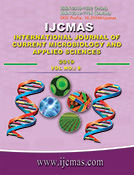


 National Academy of Agricultural Sciences (NAAS)
National Academy of Agricultural Sciences (NAAS)

|
PRINT ISSN : 2319-7692
Online ISSN : 2319-7706 Issues : 12 per year Publisher : Excellent Publishers Email : editorijcmas@gmail.com / submit@ijcmas.com Editor-in-chief: Dr.M.Prakash Index Copernicus ICV 2018: 95.39 NAAS RATING 2020: 5.38 |
A field experiment was conducted at the Agriculture farm, Institute of agriculture, sriniketan, Visva-Bharati, West Bengal, India, during rabi season of 2014-2015 and 2015-2016. The experiment was laid out in randomized block design with three replications, assigning 24 treatments consisting of three levels of Zinc (10, 20 and 30 kg/ha), Boron (0.5 and 1 kg/ha with one foliar spray @ 0.5%) and Molybdenum (0.5, 1 and 1.5 kg/ha) with and without Rhizobium inoculation. Grain yield increased with micronutrient application and the highest grain yield (977.2 kg/ha) was obtained where Rhizobium was applied along with micronutrients i.e. RDF + Rhizo. + Zn (20kg/ha) + B (0.5kg/ha) + Mo (1kg/ha). Rhizobium and Micronutrient application also influenced significantly the stover yield and the highest stover yield (2144.3 kg/ha) was recorded in the same treatment where we got the highest grain yield. These result shows that application of micronutrients upto second level along with Rhizobium inoculation was more effective for growth and yield of chickpea. Micronutrients and biofertilizer application also influenced significantly the yield attributes i.e., pods per plant, plant height except seed per pod and test weight.
 |
 |
 |
 |
 |